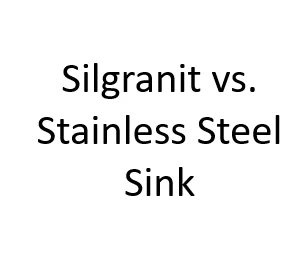When it comes to designing and equipping a modern kitchen, one of the key decisions homeowners face is choosing the right type of sink. Two popular choices that often come into consideration are silgranit and stainless steel sinks. Each material has its own set of advantages and drawbacks, catering to different preferences and needs. In this blog post, we’ll delve into the world of silgranit and stainless steel sinks, comparing their features, benefits, and drawbacks to help you make an informed decision for your kitchen.
Comparing Silgranit and Stainless Steel Sinks
Material Composition
Silgranit Sinks: Crafted from a composite material comprising 80% natural granite stone and high-quality acrylic resins, silgranit sinks create a durable and heat-resistant surface designed to withstand daily use and potential impact.
Stainless Steel Sinks: Stainless steel sinks are made primarily from a combination of steel, nickel, and chromium. The material is known for its corrosion resistance and sleek appearance, making it a popular choice in modern kitchens.
Durability
Silgranit Sinks: Silgranit sinks are lauded for their exceptional durability. The blend of natural granite and acrylic resins creates a sink surface that is resistant to chipping, scratching, and impact. This makes silgranit sinks ideal for households with busy kitchens and heavy use.
Stainless Steel Sinks: While stainless steel sinks are generally durable and resistant to staining, they can be susceptible to scratching and denting over time. However, modern manufacturing techniques have led to the production of higher gauge stainless steel sinks that are less prone to these issues.
Aesthetics
Silgranit Sinks: Silgranit sinks come in a variety of colors and finishes, allowing homeowners to match them to their kitchen decor. The granite-like appearance adds a touch of elegance and natural beauty to the kitchen space.
Stainless Steel Sinks: Stainless steel sinks are known for their sleek and contemporary appearance. They blend seamlessly with modern kitchen appliances and are available in various finishes to complement different design aesthetics.
Maintenance and Cleaning
Silgranit Sinks: Silgranit sinks are relatively easy to clean due to their non-porous surface. Stains and residues are less likely to adhere to the material, and a simple wipe-down with mild soap and water can usually suffice.
Stainless Steel Sinks: Stainless steel sinks can show water spots and fingerprints more easily, requiring regular cleaning to maintain their shine. However, they are also easy to clean with basic household cleaners.
Heat and Stain Resistance
Silgranit Sinks: Silgranit sinks are heat-resistant and can handle hot pots and pans without sustaining damage. The composite material is also less likely to be stained by acidic foods and liquids.
Stainless Steel Sinks: Stainless steel sinks are highly heat-resistant, making them suitable for handling hot items directly from the stove or oven. However, they can be more susceptible to staining from certain substances.
Price Range
Silgranit Sinks: Silgranit sinks are generally considered to be in the mid to high price range due to their durability and aesthetic appeal.
Stainless Steel Sinks: Stainless steel sinks are available in a wide price range, making them accessible for a variety of budgets. Higher gauge stainless steel sinks tend to be more expensive due to their enhanced durability.
The Decision-Making Process
To help you further in making the right choice between silgranit and stainless steel sinks, here are a few additional factors to consider:
Kitchen Style:
Evaluate the overall style of your kitchen. If you have a more traditional or rustic design, the natural appearance of silgranit sinks might complement the space well. For modern and contemporary kitchens, stainless steel sinks are a popular choice due to their sleek and minimalist look.
Cooking Habits:
Consider your cooking habits and the types of utensils and cookware you use. If you frequently handle heavy pots and pans, a silgranit sink’s durability might be more appealing. On the other hand, if you’re concerned about potential scratches and dents, stainless steel sinks can handle heavy-duty use.
Maintenance Preferences:
Think about how much time you’re willing to dedicate to sink maintenance. Silgranit sinks tend to be easier to clean and resist stains, making them a great option for those who prefer minimal upkeep. If you don’t mind occasional cleaning to maintain the shine, stainless steel sinks can still provide a stunning look.
Budget Considerations:
Your budget will play a significant role in your decision. Silgranit sinks generally come at a higher price point due to their durability and aesthetics. Stainless steel sinks offer more flexibility in terms of pricing, allowing you to find an option that fits your budget.
Noise and Insulation:
Another aspect to consider is sound. Stainless steel sinks can sometimes be noisier due to the metal’s nature, but some models come with insulation pads to reduce noise. Silgranit sinks, on the other hand, tend to be quieter due to their composite construction.
Long-Term Value:
While both types of sinks can provide long-term value, silgranit sinks’ resistance to chipping and scratching might give them a slight edge in this aspect. However, with proper care, a high-quality stainless steel sink can also last for many years.
The Verdict
In the end, the choice between silgranit and stainless steel sinks largely depends on your personal preferences and the specific needs of your kitchen. If you prioritize durability, impact resistance, and a wide range of color options, a silgranit sink could suit you perfectly. Conversely, if you prefer a modern and sleek aesthetic, along with varying price points, a stainless steel sink might be more suitable.
Regardless of your decision, investing in a quality sink from a reputable manufacturer will ensure that you’re getting a product that’s built to last. Be sure to read reviews, consider warranties, and explore different brands before making your final choice.
In Conclusion
Selecting the perfect sink for your kitchen is an important decision that can impact both the functionality and appearance of the space. Silgranit and stainless steel sinks each have their own set of advantages and drawbacks, making them suitable for different preferences and lifestyles. By considering factors such as material composition, durability, aesthetics, maintenance, and budget, you’ll be better equipped to make an informed decision that aligns with your needs and vision for your kitchen.
In the end, both silgranit and stainless steel sinks can be excellent additions to your home, elevating your kitchen’s functionality and aesthetics for years to come. Whether you opt for the natural elegance of silgranit or the contemporary allure of stainless steel, your chosen sink will undoubtedly play a vital role in your kitchen’s daily activities and overall design.

